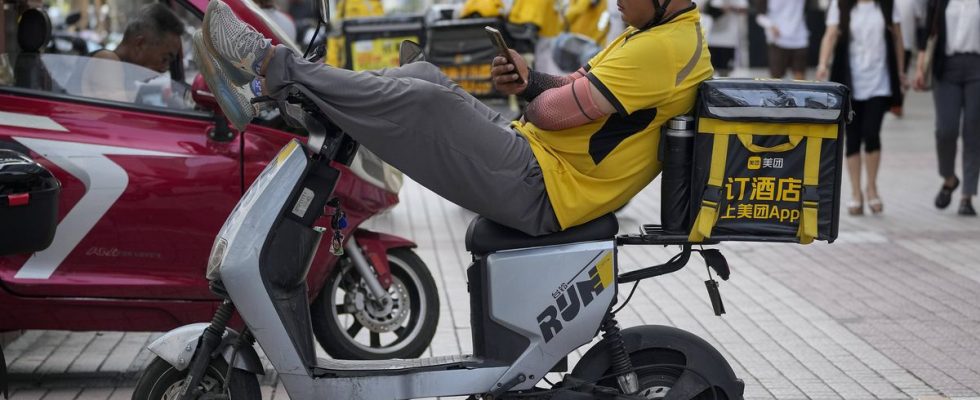The effect is known. The flap of a butterfly’s wings in Brazil can cause a tornado in Texas. Let us then place China’s economic slowdown at the start of this chain of dominoes. A different pedigree than the frail insect: second power on the planet, “factory of the world” and “engine of its growth”. Should we then fear that the butterfly effect will turn into a tornado?
Real estate crisis, youth unemployment and other reasons mentioned in this recent article… It’s hard to deny that the giant’s economy is sputtering like it rarely does. But if times are tough in this 2023 vintage, China’s slowdown goes back much longer. Between 2001 and 2011, the country experienced average annual growth of 11.5%, according to World Bank data. And between 2011 and 2019, before Covid-19? “Only” 7.1%. Figures which have shrunk further with the pandemic – we will come back to that. “The world, and France, are already affected by the Chinese slowdown,” indicates Véronique Riches Flores, independent economist.
German ricochet effect
The endless inflation since 2021, which you see at each checkout, is notably due to the shutdown of Chinese production with its Zero Covid policy – which confined cities and shut down entire factories at the slightest case detected. Less production, less supply, still as much demand = rising prices.
We could reassure ourselves by saying that “France ultimately exchanges relatively little with Beijing,” recalls Stéphanie Villers, macro-economist and advisor at PwC France. Our exports are mainly focused on aeronautics and luxury, markets relatively little affected by the crises,” believes the specialist. Less than 4% of French exports go to China. So even if the country no longer consumes, this does not weigh too much on our own balance sheet.
In the other direction, even if Beijing remains France’s second supplier, this represents less than 10% of our imports. However, the domino effect requires that a weakness in China fatally affects France – in particular because Paris’ first trading partner, Germany, is much more dependent. China accounts for a fifth of its trade. In short: when Beijing has the flu, Berlin has a fever, and as a result, Paris coughs.
China, from savior to gravedigger of the world economy?
And it’s not just Germany. Most emerging countries, rich in raw materials that China loves to support its consumption, are dependent. In 2010, China appeared as the country “which allowed the world to get out of the 2007-2008 crisis”, summarizes Véronique Riches Flores, thanks to an upper middle class and high consumption. Practical, whether for Germany – with the export sales of its cars, which had doubled between 2008 and 2010 – or Brazil, which experienced a jump in growth between 2008 and 2012.
But from 2012, the machine jammed. “Since the middle of the 2010 decade, China’s role as locomotive has been seriously broken,” continues Véronique Riches Flores. Domestic demand is falling. On a global scale, the 2011-2019 period saw growth of 3% on average, far from idyllic, and above all one point less on average than the previous decade.
A long paradigm shift
The current Chinese difficulties should logically make things worse: fewer exports for Europe and ever more expensive imports. Except that over the past decade that the Asian giant has been slowing down, the world is slowly learning to no longer put all its eggs in one basket. “The model of globalization, driven by China, is increasingly being called into question,” believes Véronique Riches Flores. Even more so since the coronavirus and China’s Zero Covid policy of 2022, which closed the “factory of the world” when other countries desperately wanted to revive their economies in full swing.
“This policy has shown all the risks to be taken, for Europeans, of depending on third countries that can decide unilaterally to cut production chains,” believes Stéphanie Villers. More and more countries are rethinking their supply method, towards closer countries – in economic language, near-sourcing – or allied countries with the same political profile – friendshoring. A desire for independence increased by the war in Ukraine, which also showed the fragility of being dependent on a third country, this time in energy.
An addiction still there
Of course, we cannot get rid of decades of globalization and rapid relocation in two years. “But the paradigm shift from global ultra-dependence on China had already begun,” believes Stéphanie Villers. It will certainly take a long time, but the West is not starting from scratch.” The amplification of the Chinese crisis just proves that the chosen path is the right one, and reindustrialization projects are flourishing everywhere on the Old Continent.
But, as we have said, the road remains long. In 2022, France imported 77 billion euros of Chinese goods – a record – compared to 46 billion in 2016. “In the short term, the Chinese slowdown is of course likely to have negative consequences. In the long term, the world is structurally preparing to depend less on them, and therefore to be less affected by their economy,” says Stéphanie Villers.
Between 2021 and 2022, the increase in Chinese imports into France (+ 22%) is almost similar to the increase in imports within the EU (+ 20%), and much lower than the increase in imports from the rest of the EU. Europe (+ 36%) or North America (+ 69%). With the exception of China and the United States, France’s eight other largest trading partners are European. Of near-sourcing and friendshoring. After the butterfly effect, another proverb: see the glass half full or half empty.

